
The Eminescu quadrangle (H-9) is one of fifteen quadrangles on Mercury. It runs from 216 to 288° longitude and from -25 to 25° latitude. Named after the Eminescu crater, it was mapped in detail for the first time after MESSENGER entered orbit around Mercury in 2011. It had not been mapped prior to that point because it was one of the six quadrangles that was not illuminated when Mariner 10 made its flybys in 1974 and 1975. These six quadrangles continued to be known by their albedo feature names, with this one known as the Solitudo Criophori quadrangle.

Raphael is a crater on Mercury. Its name was adopted by the International Astronomical Union (IAU) in 1976, and is named for the Italian painter Raphael. It is Tolstojan in age.
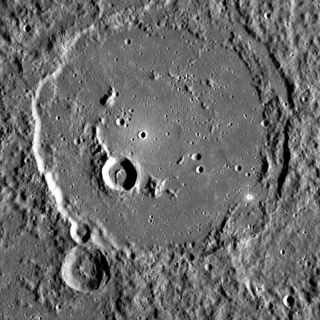
Polygnotus is a crater on Mercury, named by the IAU in 1976, after ancient Greek painter Polygnotus.

Praxiteles is a crater on Mercury. It is one of 110 peak ring basins on Mercury.

Munkácsy, named after Mihály Munkácsy, is a crater on Mercury. Munkácsy originally had a double-ring basin structure, but most of the inner ring was buried when the basin was flooded with volcanic lava. Only a few remnants of the ring poke up through the lava, although low ridges in the lava seem to trace out much of the rest of the ring's circumference. Munkácsy is one of 110 peak ring basins on Mercury.

Izquierdo is a crater on Mercury. Its name was adopted by the International Astronomical Union (IAU) in 2009, for the Mexican painter María Izquierdo. The floor of Izquierdo is smooth, the result of having been partially filled with volcanic lava. Circular outlines of the rims of “ghost craters” – smaller, older craters that have been largely buried by the lavas that infilled the basin – are visible in a few places on Izquierdo's floor. The remnants of a buried inner ring are also barely discernible in spots, and it is one of 110 peak ring basins on Mercury. There have been more recent impacts into the floor of Izquierdo, resulting in some small, sharply defined craters.
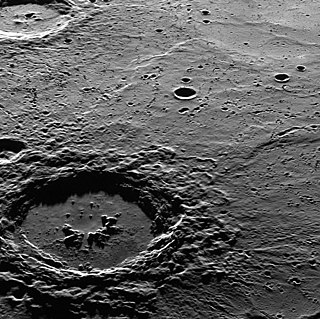
Hokusai is a rayed impact crater on Mercury, which was discovered in 1991 by ground-based radar observations conducted at Goldstone Observatory. The crater was initially known as feature B. Its appearance was so dissimilar to other impact craters that it was once thought to be a shield volcano. However, improved radar images by the Arecibo Observatory obtained later in 2000–2005 clearly showed that feature B is an impact crater with an extensive ray system. The bright appearance of rays in the radio images indicates that the crater is geologically young; fresh impact ejecta has a rough surface, which leads to strong scattering of radio waves.
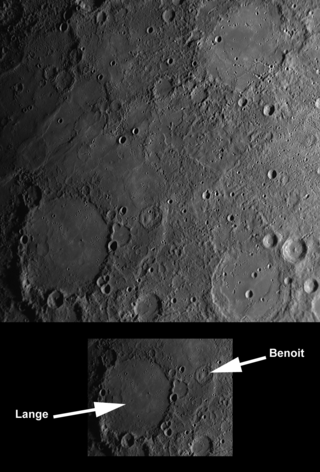
Lange is a crater on Mercury. It was named by the IAU in 2009 after American photographer Dorothea Lange.

Ahmad Baba is a crater on Mercury. It has a diameter of 127 kilometers. Its name was adopted by the International Astronomical Union (IAU) in 1979.

Leopardi is a crater on Mercury. Its name was adopted by the International Astronomical Union in 1976. Leopardi is named for the Italian writer Giacomo Leopardi, who lived from 1798 to 1837.

Mark Twain is a crater on Mercury. Its name was adopted by the International Astronomical Union (IAU) in 1976. Mark Twain is named for the American author Mark Twain, who lived from 1835 to 1910.

Holst is a crater on Mercury. Its name was adopted by the International Astronomical Union (IAU) on April 24, 2012.
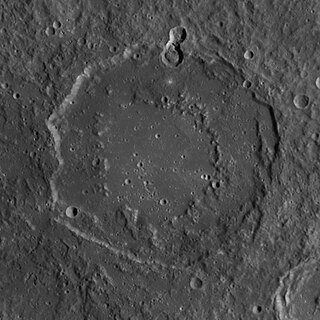
Nabokov is a crater on Mercury. Its name was adopted by the International Astronomical Union (IAU) on April 24, 2012. Nabokov is named for the Russian and American author Vladimir Nabokov.

Villa-Lobos is a crater on Mercury. Its name was adopted by the International Astronomical Union (IAU) on September 25, 2015. Villa-Lobos is named for the Brazilian composer Heitor Villa-Lobos.

Seuss is a crater on Mercury. Its name was adopted by the International Astronomical Union (IAU) in 2012. It is named for the American author and cartoonist Theodor Seuss Geisel, better known as Dr. Seuss.

Faulkner is a crater on Mercury. It has a diameter of 168 kilometres. Its name was adopted by the International Astronomical Union (IAU) on April 24, 2012. Faulkner is named for the American author William Faulkner.
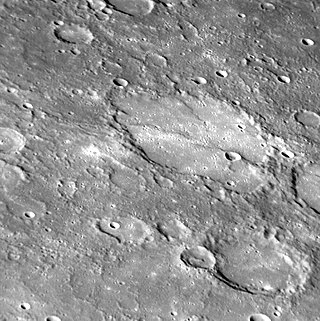
Savage is a crater on Mercury. Its name was adopted by the International Astronomical Union (IAU) in 2013, and is named for the American sculptor Augusta Savage.

Wen Tianxiang is a crater on Mercury. Its name was adopted by the International Astronomical Union (IAU) in June 2020, and it is named for Chinese writer and poet Wen Tianxiang.





















